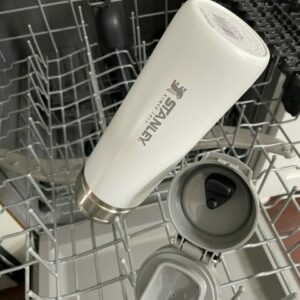Look, I get it. After a long day on the trails, the last thing you want to do is scrub your grimy Stanley water bottle by hand. Tossing it in the dishwasher seems so convenient. But resist the urge, my friends!
As a Stanley fan who’s relied on these burly bottles for years, let me lay down some real talk about Stanley and the dishwasher. Could you wash your Stanley that way? Technically, yes. But I don’t recommend that you make a habit of it.
Choosing convenience over longevity is your call. But if you want that trusted Stanley to kick strong for years of adventures, keep dishwasher rides to a bare minimum. Handwashing shows a little love.
OK, let’s get into the nitty-gritty of dishwasher dos and don’ts for your Stanley…
So, Can I put my Stanley bottle in the dishwasher?

Technically, yes. Stanley bottles are engineered to allow occasional trips through the dishwasher without damage. But for longevity, handwashing is strongly recommended whenever possible. Here’s how to dishwasher safely if you must.
While handwashing is ideal, occasional dishwasher use won’t ruin a Stanley bottle when basic care is taken. With smart, integrated use of both cleaning methods, your Stanley can deliver pristine hydration for years on end.
What are the risks of Putting A Stanley bottle In The Dishwasher?
I can understand that you might want to just chuck that grimy post-hike Stanley into the dishwasher. But hold up! While those durable babies can survive a few trips through a gentle cycle, repeated dishwasher use can thrash your bottle’s paint job and degrade seals quickly. Not to mention demolishing delicate straws as they get thrashed around.
Repeated dishwasher use does put Stanley bottles at risk for:
- Degraded seals and gaskets from prolonged heat and harsh detergents
- Chipped or dulled exterior paint or powder coat from collisions and abrasion
- Potential reactions between cleaners and bottle components
- Warped or melted plastics if water jets are blocked
With care, these risks can be minimized. But manual washing avoids them entirely.
How does Stanley make bottles dishwasher-safe?
To survive occasional dishwasher rides, Stanley uses beastly stainless steel that laughs off steamy heat and pressure. Their powder coat paint stands up to collisions with plates and cutlery without chipping or peeling. The plastics withstand warping from hot cycles too. And the seals preserve the vacuum despite brutal high-temperature washing.
Basically, Stanley engineers their bottles to withstand way more abuse than a typical dishwasher can churn out. Just don’t test the limits!
To withstand dishwasher conditions, Stanley uses:
- Durable food-grade stainless steel to resist heat, pressure, and steam
- Resilient powder coat finishes that won’t crack, peel or fade
- BPA-free plastics that maintain integrity when washing
- Leakproof seals and gaskets that won’t warp or fail
- Streamlined shapes without delicate decor parts
- Optional protective silicone sleeves to shield the exterior
Repeated testing ensures Stanley bottles outlive casual cleaning cycles.
How should I prep my Stanley bottle for the dishwasher?
Before dishwashing, be sure to fully empty out all water so gunk doesn’t dry on. Remove any detachable parts like lids, seals, and straws. Give the bottle a quick rinse to remove debris that could clog the wash jets. And place it gently on the lower rack, away from sharp utensils.
Proper loading avoids damage and allows the dishwasher to work its magic on your bottle’s nooks and crannies.
Before dishwashing, always:
- Fully empty liquid contents to prevent gunky residue buildup
- Remove any detachable parts—lids, seals, sleeves, etc.
- Quickly rinse or brush away any stubborn debris that could block wash jets
- Carefully place your Stanley bottle in the dishwasher rack away from sharp cutlery to prevent scratches
Proper loading avoids damage and allows full cleaning.
What parts of my Stanley bottle can handle the dishwasher?
The beastly stainless steel body can withstand the dishwasher’s chaos with no problem. Most plastic lids and handles also hold up just fine. But silicone sleeves and delicate straws better come out beforehand unless you like melted plastic bits on your dishes! When in doubt, I remove all accessories and parts before a wash cycle.
While the bottles themselves tolerate dishwasher cleaning, some parts and accessories do not:
- Stainless steel inner and outer walls are dishwasher-safe
- Most plastic lids, handles, and base pads can withstand washing
- Silicone sleeves protect exteriors but may degrade faster from heat
- Slender straws and electronics risk damage and should be hand-washed
When in doubt, remove parts and hand wash separately to be safe.
Is hand washing the better option for Stanley bottles?
While the dishwasher won’t ruin them, hand washing is still the recommended method. WHY?
More Gentle: Controlled cleaning without abrasive heat, pressure, or jostling
More Thorough: Soft brush cleans hard-to-reach spots like straws and lid gaps
Spot Treatable: Can target specific problem residues more safely
Longevity: Reduces seal and gasket wear compared to dishwashers over time
Eco-Friendly: Conserves water and detergent compared to full dishwasher loads
Daily hand washing provides easy, low-impact upkeep after each use.
What are the best cleaning methods for Stanley bottles?
My advice? Stick to handwashing whenever you can. It’s quick with some soapy water and a bottle brush. Keeps your Stanley looking slick. For a really deep clean, some hot vinegar works miracles.
But when life gets hectic, I’m with you. With the occasional quick dishwasher cycle, your Stanley will survive. Just use the gentle/quick wash setting, skip the brutal heated drying, and keep plastics off the bottom rack pins. Lay that baby down flat if you must.
To properly care for your Stanley bottle:
Daily Hand Washing
- Use mild, eco-friendly dish soap and warm water
- Disassemble all parts: lids, seals, sleeves, and straws
- Clean with a soft sponge or bottle brush, reaching inside crevices
- Rinse thoroughly until no soap residue remains
Periodic Disinfecting
- Fill with warm water and distilled white vinegar to disinfect and descale
- Baking soda and white vinegar solution to remove odors and residue
- Sanitizing tablets with warm water sterilizes; just rinse thoroughly before using the bottle again
Combine quick daily hand washing with occasional deep cleaning for peak performance.
Any dishwasher tips to protect Stanley bottle finishes?
If dishwashing, use these tips to maintain a flawless finish:
- Opt for gentle cycles, not heavy-duty modes
- Choose eco-friendly gels without caustic alkaline formulas or bleach
- Allow the bottle to air dry to prevent mineral water spots
After washing your Stanley bottle, show your Stanley some TLC. Inspect closely for any scratches or cracks. Oh, and hit the stainless steel with some lemon juice or vinegar to dissolve any mineral residue left behind. Citric acid pimps a dull Stanley right up.
What dishwasher detergents should I avoid?
Avoid dishwasher detergents containing:
- Bleach or chlorine compounds can react with bottle parts
- Caustic additives like lye or alkaline builders degrade coatings
- Salts or rinsing agents cause abrasions
- Heavy fragrances can leave residue on surfaces
- Degreasing agents erode rubber seals and gaskets
Choose a mild, fragrance-free gel for the best results.
How Often Can I Safely Put A Stanley Bottle In A Dishwasher?
Limit dishwasher cycles to just 1-2 times per month. For frequently used bottles, handwash daily instead. Inspect closely after washing and cease use immediately if cracks, clouding, or erosion are visible. Plan to replace gaskets and seals periodically as needed.
Moderation minimizes damage when dishwashing Stanleys. But handwashing is always best for longevity!
While Stanley bottles tolerate occasional dishwasher use, moderation is wise.
- Limit to just 1-2 wash cycles per month, maximum
- For frequent-use bottles, hand wash daily instead
- Inspect closely after washing; cease use immediately if cracks, cloudiness, or damage are found
- Plan to replace gaskets and seals periodically, as needed
With prudent, moderated use, your Stanley can handle the dishwasher safely. But don’t overdo it.
FAQs about dishwashing Stanley bottles
Does the dishwasher impact Stanley’s insulation?
No negative effect: the vacuum seal and double wall insulation remain fully functional after washing. Just avoid freezing the bottle immediately after washing before the contents cool.
Can I use heated drying cycles?
It is best to skip heated drying and instead fully air-dry Stanley bottles to prevent exterior dulling and mineral buildup from water spots.
Top or bottom rack—which is better?
The bottom rack allows free spinning for optimal interior cleaning access. Avoid crowded top racks where bottles may not get a thorough cleaning.
How do I remove mineral deposits after washing?
Fill your Stanley bottle with white vinegar and warm water to dissolve any calcium or lime buildup after dishwasher use. Use a bottle brush on stubborn inner spots.
I feel your busy life struggle, though. If your Stanley is utterly disgusting post-camping, knee-deep in trail mix and mud, a dishwasher won’t kill it. Just don’t make it a habit and use gentle settings. A little TLC goes a long way. But hey, at the end of the day, you do! If you must dishwash that filthy Stan, at least show it some mercy. The soft life is not the Stanley way!
While handwashing is best, occasional dishwasher use won’t ruin a Stanley bottle when basic care is taken. With smart, integrated use of both methods, your Stanley can deliver pristine hydration for years on end.

About Me
I’m Paul Burkhardt, an expert in water and water treatment since 2006 with in-depth experience not only in treating water but also in helping to provide people with healthier, high-quality drinking water.
I’ve helped thousands of people with their drinking water questions, including what kind of water bottle might be best for them and their lifestyle.
If you’d like more information about me, please check out the links below or read more here:

